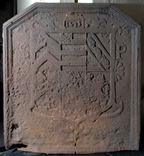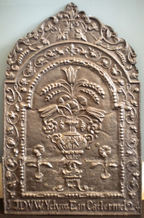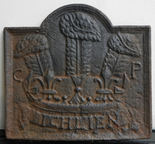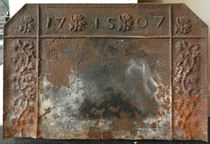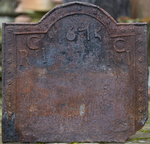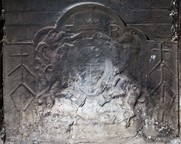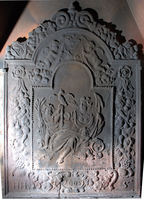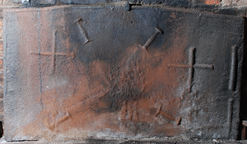-
924
Description: Canted rectangle; elaborate cavetto moulded edging (top and sides); strapwork shield with a demi-flower at each side, between initials; arms quarterly of six, 1st Or two chevronels Gules, on a canton of the last a mullet of the first (Pope); 2nd Argent three bars Gules, on a canton ermine a bend of lozenges of the second (Walshe); 3rd Sable three laurel leaves in bend Or between two bendlets Argent (Waller); 4th Azure a chevron between three crosses Moline Argent (Lansdale); 5th Ermine on a bend Gules three lions' heads erased Or (Weston); 6th Azure a lion rampant Or supporting a cross pat?e fitch?e of the second (Pichingham).
Notes: The lower part of the shield is revealed more clearly in another casting. The date above the shield has been inserted before casting and differs slightly from another example of the same back.
Copies of this fireback are known.
Inscription: 1625 / S P
Arms: Pope (Sackevile Pope (b. 1589) of Hendall, in Buxted, Sussex)
- Decoration tags:
- rectangular with canted top corners (shape)
- complex individual (edging)
- whole carved pattern
- date stamp
- armorial
- text
Manufactured: in 1625 in the Weald area of England.
Current location:, L.T.C. Rolt - Life, Work, Legacy A Joint Ironbridge Gorge Museum Trust / Keele University Conference 9th - 11th May 2024 Ironbridge Gorge Museum, Coalbrookdale, Shropshire Click here for details.
- Attached to series:
- Low relief armorial series
- Personal armorial firebacks
-
885
Description: Arched rectangular shaped central panel, bead-and-pellet edging, narrow-necked, two-handled urn with flowers and wheat ears issuing therefrom, the vase resting on a wall with stone courses, against which are two small flowers in pots with a stool between; arched rectangular shaped border with fillet edging and symmetrical floral tendrils, a looped 'W' in each shoulder; on top, mirrored leaves, tendrils and wheat ears; inscription along bottom of border.
Notes: One of the two largest of six flower vase designs in this series (see also no. 858). All incorporate the looped 'W' motif which may be intended to identify the pattern maker. The casting is an amalgamation of parts of two firebacks of the same design, the bottom portion from an earlier casting than the top (reduction 2%). The inscription translates as 'God is our strength'.
Inscription: 17 DVW Ydyw Ein Cadernid 24
Manufactured: in 1724 in England.
Current location: not known.
- Attached to series:
- 1724 series
- British 'Dutch' style firebacks
- Welsh inscription series
-
886
Description: Arched rectangular central panel with ‘nutshell’ edging on a broad fillet; head-dressed figure, holding a sceptre in her right hand, sitting in a chariot drawn to the left by two armadillos; the whole upon a two-arched bridge with masonry, decorated keystones and spandrels, and waves beneath; above, swagged drapery with two tassels hanging from the centre; arched rectangular shaped border with fillet edging, with a symmetrical scrolled wire design; the monogram, SHR, bottom centre; above is a symmetrical design of scrolled floral tendrils.
Notes: The design is derived from a personification of America, one of a set of playing cards entitled 'Jeu de la Géographie', designed by Stefano della Bella (1677).
Copies of this fireback are known.
Inscription: SHR
- Decoration tags:
- 'Dutch' (shape)
- fillet (edging)
- whole carved pattern
- pictorial
- architectural
- text
- animals
- humans
- objects
Manufactured: in the late-17th to early-18th century in England.
Current location: not known.
- Attached to series:
- SHR series
- British 'Dutch' style firebacks
-
891
Description: Quasi-arched rectangular shaped; unique, cavetto-moulded edging, which loops upon itself three times. A mythical salamander shown in the flames which legend states it is able to resist; behind is what appears to be a palm tree.
Notes: Other known variants are dated; this variant confirms that the dates were added to subsequent castings. Corrosion to the bottom right corner may have obliterated a letter 'M' seen on another casting; presumably part of 'IM'.
- Decoration tags:
- rectangular with ornate arch (shape)
- cavetto (edging)
- whole carved pattern
- pictorial
- mythological
- animals
Manufactured: in the mid-17th century possibly at Brede Furnace in the Weald area of England.
Current location: not known.
Citation: Schubert, H. R., 1957, 'A Forgery in Iron', Journal of the Iron & Steel Institute, 165, p. 125.
- Attached to series:
- Hooked '1' series
- Loop edged firebacks
- Brede group
-
198
Description: Arched rectangular shape; cavetto-moulded edging; English royal coronet with three ostrich feathers rising from within; below, a motto scroll with inscription.
Notes: The badge of the Prince of Wales; the initials, CP, are probably for Carolus Princep; the motto is mis-spelled in error for 'Ich Dien' - I serve, which is more likely a mistranscription rather than a deliberate slur. The apparent crack in the angle of the arch and the top left of the fireback is an impression, indicating that this is a recasting.
Copies of this fireback are known.
Inscription: C P/ICH LIEN
- Decoration tags:
- rectangular with round arch (shape)
- cavetto (edging)
- whole carved pattern
- heraldic
- royal
- text
Manufactured: in the mid-17th century possibly in the Weald area of England.
Current location: not known.
- Attached to series:
- Prince of Wales firebacks
-
910
Description: Canted rectangle; cavetto-moulded edging (top and sides); single horizontal fillet below canted corners and vertical fillet parallel to each side, dividing the fireback into two side panels, two top corner panels, top panel and main central panel; corner panels, ‘daisy’ plant stamp; top panel, central initials between split date, separated by 'daisy' stamps; side panels, swirling foliage stamp repeated each side, initial at bottom of panel: I to the left, B to the right.
Notes: The 'daisy' stamp and the IB initials are found on other backs in a distinct series. The foliage stamp is not known on other backs in the series. Christie's Interiors - Masters & Makers (Sale 5462), South Kensington, London, 8 July 2014, lot 126 (£688).
Inscription: 17 IS 07 / I B
- Decoration tags:
- rectangular with canted top corners (shape)
- cavetto (edging)
- carved stamps
- individual letters
- individual numbers
- text
- plants
Manufactured: in 1707 in the Forest of Dean area of England.
Current location: not known.
- Attached to series:
- IB series
- Date & initials firebacks
-
978
Description: Arched rectangular shape; twisted rope edging with inaccurately parallel arched rectangular fillet inside, enclosing repeated small fleur-de-lys stamps along sides and top; initials in triad in each of the internal top corners; date in arch.
Notes: The initials probably relate to a couple whose surname begins with C, the husband's forename initial being R and the wife's I (or J).
Inscription: RCI/ 1675 / RCI
- Decoration tags:
- rectangular with round arch (shape)
- rope (edging)
- simple stamps
- carved stamps
- individual letters
- individual numbers
- heraldic
- text
Manufactured: in 1675 in England.
Current location: not known.
- Attached to series:
- Date & initials firebacks
-
1248
Description: Central arched rectangular shape with rounded corners; ovolo moulding all round; oval Tudor royal shield with garter surrounding, topped with a royal crown; dragon and greyhound supporters; initials split by crown; all details below shield illegible; rectangular extension panels on each side, with twisted rope edging; quasi mirrored arrangement of twisted rope lengths to form (from the top) a cross, a vertical pointing arrow, and a diamond shape with a central vertical line.
Notes: The detail of the extension panel is sharper than the armorial, indicating that the panel was cast with a worn copy of the armorial. Illustrated in Weaver, 1914, p. 16.
Inscription: E R [+ Garter, Harvo and royal mottoes, all illegible]
Arms: Tudor royal (prob. Henry VIII)
- Decoration tags:
- rectangular with round arch (shape)
- rope and ovolo moulding (edging)
- simple stamps
- whole carved pattern
- extension panels
- heraldic
- apotropaic
- armorial
- royal
- text
- objects
Manufactured: in the late-16th to early-17th century in the Weald area of England.
Current location: in private hands, Plaistow, West Sussex, England.
Citation: Weaver, L., 1914, Small Country Houses: their repair and enlargement (London, Country Life).
- Attached to series:
- Pounsley series
- John Harvo series
- Tudor royal armorial firebacks
-
586
Description: Arched rectangular shaped central panel with bead edging; pictorial scene of a seated female figure resting against a hurdle, holding an anchor, a child on each side of her, the one on the left standing clutching corn stalks, the one on the right sitting also holding the anchor and a circular object; a bird sits on a post; arched rectangular border with bead edging; fructal and floral festoons suspended on ribbons with two putti at the top and two on each side; in the left and right bottom corners, the initials 'HH' and 'S' respectively; at the bottom, a central cartouche with date, between floral swags; on top, twin spirals between descending floral festoons.
Notes: The figure is an allegory of Hope. The theft in 1699 from a Thames-side warehouse of several firebacks, including '3 of Hope with an Anchor' may refer to this type (Post Boy 11-14 Nov. 1699).
Copies of this fireback are known.
Inscription: HH 1665 S
- Decoration tags:
- 'Dutch' (shape)
- ovolo (edging)
- whole carved pattern
- pictorial
- allegorical
- text
- animals
- humans
- objects
Manufactured: in 1665 in the Siegerland area of Germany.
Current location: in private hands, Plaxtol, Kent, England.
- Attached to series:
- 'Dutch' HHS series
- Hope firebacks
-
587
Description: Quasi-rectangular; grooved dowel edging (top and sides); four impressions of a rondel dagger (c.330mm) saltirewise between two dowel crosses; two vertical lengths of dowel in line along right edge.
Notes: Rondel daggers were common in the 15th and 16th century. Grooved lengths of dowel are to be seen on other firebacks suggesting a common source. The arrangement of the daggers (each approx. 35cm long) in a saltire may also have apotropaic significance.
- Decoration tags:
- rectangular (shape)
- grooved dowel (edging)
- simple stamps
- apotropaic
- objects
Manufactured: in the mid-16th century in the Weald area of England.
Current location: in private hands, Plaxtol, Kent, England.
- Attached to series:
- Grooved dowel series
- Knife & Dagger stamp firebacks
